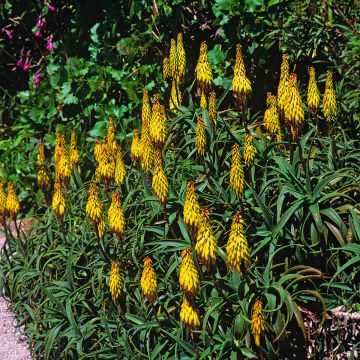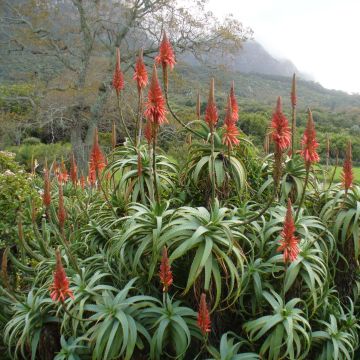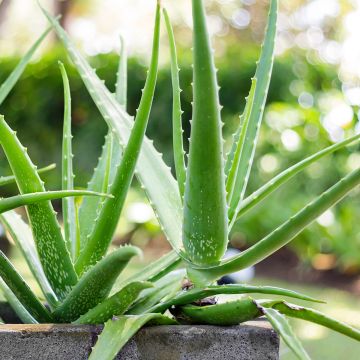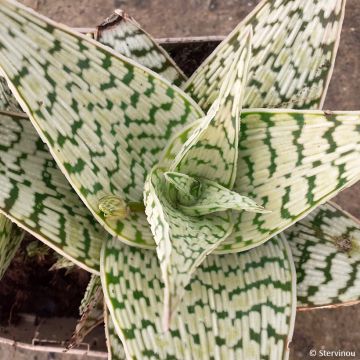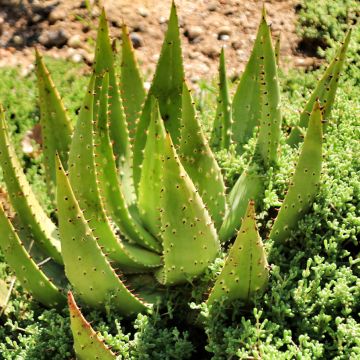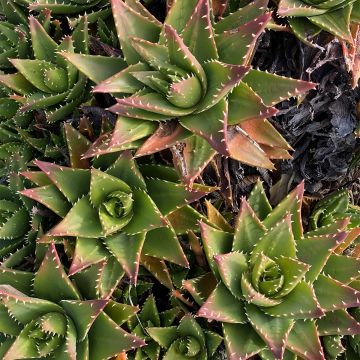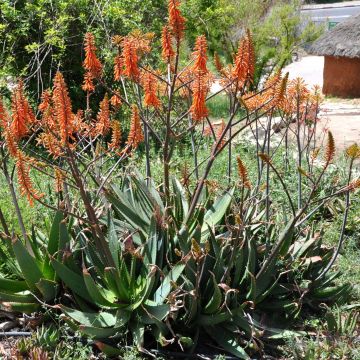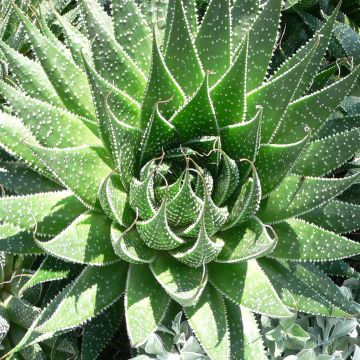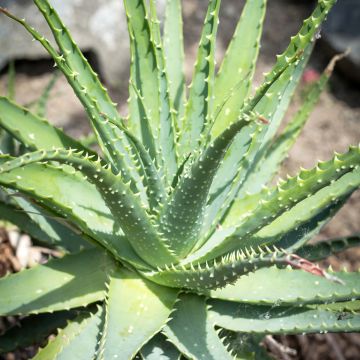

Aloe bainesii ou Aloe barberae - Aloès en arbre


Aloe bainesii ou Aloe barberae - Aloès en arbre


Aloe bainesii ou Aloe barberae - Aloès en arbre


Aloe bainesii ou Aloe barberae - Aloès en arbre


Aloe bainesii ou Aloe barberae - Aloès en arbre


Aloe bainesii ou Aloe barberae - Aloès en arbre
Aloidendron barberae
Aloe barberae
Beautiful young plant received in good condition, leaves nice and green, potting soil a bit dry which I promptly watered, package very well done.
Serge, 19/04/2023
Special offer!
Receive a €20 voucher for any order over €90 (excluding delivery costs, credit notes, and plastic-free options)!
1- Add your favorite plants to your cart.
2- Once you have reached €90, confirm your order (you can even choose the delivery date!).
3- As soon as your order is shipped, you will receive an email containing your voucher code, valid for 3 months (90 days).
Your voucher is unique and can only be used once, for any order with a minimum value of €20, excluding delivery costs.
Can be combined with other current offers, non-divisible and non-refundable.
Why not try an alternative variety in stock?
View all →This plant carries a 24 months recovery warranty
More information
We guarantee the quality of our plants for a full growing cycle, and will replace at our expense any plant that fails to recover under normal climatic and planting conditions.
Would this plant suit my garden?
Set up your Plantfit profile →
Description
Aloe barberae, or Aloe bainesii, is the most impressive species of the genus. Native to South Africa, this plant forms true trees with a massive trunk dividing into multiple branches. Each branch carries a rosette of long, slender leaves gracefully arched, giving it a very distinctive silhouette. In winter the plant produces long spikes of pink-orange flowers with a geometric shape. Sensitive to frost, it only grows in the most sheltered gardens of warm coastal reagions, in a sunny site. Outside of these privileged areas, it will be cultivated in pots and protected from frost during winter.
Now renamed Aloidendron barberae by botanists, this amazing plant now belongs to the Asphodelaceae family, which includes Aloaceae, Hemerocallidaceae, and Xanthorrhoeaceae. These are bulbous plants, with caudex (including trees), or succulents, all adaptations to their fairly arid natural environment. With only 6 or 7 species, the Aloidendron genus was separated in 2013 from the vast group of Aloes, which includes hundreds of species.
Aloidendron barberae is native to the southern part of the African continent (Mozambique and South Africa), where it grows in the bush and subtropical coastal forests. In its native habitat it reaches impressive dimensions, up to 15 or even 18 metres (60 feet) in height, with a tree-like morphology. It forms a massive trunk, measuring from 90 cm (35 in) to 2.50 m (8 ft) in diameter for the oldest specimens. The rough bark is grey and resembles elephant skin. The trunk divides into main axes, which further branch in a di- or trichotomous manner (2 or 3 branches), forming a more or less regular rounded crown. Each branch carries a rosette of dark green leaves, measuring 60 to 90 cm (24 - 35 in) in length. Only 7 to 9 cm (2.8 - 3.5 in) wide, they are very slender and curve downwards. Fleshy and leathery, they have a gutter-shaped duct and are bordered by small 2 to 3 mm (0.1 in) long teeth.
In winter, long inflorescences measuring from 40 to 60 cm (15 - 24 in) appear, either single or more often divided into 2 racemes, forming spikes measuring 20 to 30 cm (8 - 12 in) in length and 8 to 10 cm (3 - 4 in) in diameter. This highly geometric structure is particularly aesthetic, with dozens of tightly packed pink to orange flowers. Measuring approximately 3.5 cm (1.4 in) in length, they have a somewhat cylindrical shape, swollen at the base, with yellow-green stamens at the tip of the corolla. In Africa, pollination is carried out by passerine birds with a curved beak.
This sculptural plant has been successfully planted in mild Mediterranean climates where it benefits from both the heat and the summer sun, as well as mild winters. It is indeed only hardy down to -3°C (26.6 °F), possibly -5°C (23 °F) for well-established plants, which greatly limits the possibilities of planting it outdoors. Where this is possible it should be placed in full sun, in neutral to acidic, well-drained soil to avoid excess moisture in the soil, especially in winter. Although adapted to drought, it will grow better if it receives regular watering in summer. It can reach a height of 4 to 6 m (13 to 20 ft) and a width of 3 to 4 meters (10 to 13 ft).
In other regions this Aloidendron can be planted in a large container and spend the summer outdoors in the sun. As winter approaches, ideally it should be brought indoors to a frost-free veranda, which will provide it with sufficient light during winter. However, it should be kept in mind that this plant has significant growth potential and may become difficult to move after a few years. An example of a species with more manageable dimensions includes Aloe arborescens.
With its characteristic silhouette, reminiscent of the famous Dragon Tree from the Canary Islands (Dracaena draco), Aloidendron barberae is an extraordinary plant. Its stunning design makes it suitable for contemporary gardens in warm areas, where it will be an exceptional focal point. It can also be the central element of an exotic scene, alongside other plants such as the Mexican Blue Palm (Brahea armata) with its magnificent fan-shaped leaves in a surprising grey-blue colour, as well as the numerous species of Opuntia capable of thriving in Mediterranean climates and forming impressive clumps. Yuccas, with their perfect rosettes of leaves and generous flowering, will also make good companions.
Report an error about the product description
Aloidendron barberae in pictures






Plant habit
Flowering
Foliage
Botanical data
Aloe
barberae
Asphodelaceae
Aloidendron barberae, Aloe bainesii
South Africa
Other Aloe
View all →Planting and care
Aloe barberae can only be planted outdoors in the mildest areas of Europe due to its low hardiness (-3°C (26.6 °F) to -5°C (23 °F) for a well-established plant in good conditions). It will require a sunny site and a fairly rich, neutral to slightly acidic, and above all well-drained soil. Water it regularly in summer to promote its growth and rooting, which will help it withstand the winter. In the first few years you can optionally protect it with a fleece in the case of slight frost. Make sure to plant it far enough away from buildings due to its potential size.
Elsewhere it will need to be planted in a large container so it can be brought indoors to a frost-free, well-lit room as soon as nighttime temperatures approach 0°C (32 °F). Mix slightly acidic potting soil with ordinary soil and a little non-alkaline sand, and place a layer of gravel at the bottom of the container to improve drainage. Such a mixture will also be heavier than pure potting soil, which will help stabilise the container as your Aloe grows. For overwintering, a frost-free conservatory, or alternatively a bright garage, will be suitable. Watering should be spaced out and the substrate allowed to dry thoroughly between waterings.
Planting period
Intended location
Care
-
, onOrder confirmed
Reply from on Promesse de fleurs
Haven't found what you were looking for?
Hardiness is the lowest winter temperature a plant can endure without suffering serious damage or even dying. However, hardiness is affected by location (a sheltered area, such as a patio), protection (winter cover) and soil type (hardiness is improved by well-drained soil).

Photo Sharing Terms & Conditions
In order to encourage gardeners to interact and share their experiences, Promesse de fleurs offers various media enabling content to be uploaded onto its Site - in particular via the ‘Photo sharing’ module.
The User agrees to refrain from:
- Posting any content that is illegal, prejudicial, insulting, racist, inciteful to hatred, revisionist, contrary to public decency, that infringes on privacy or on the privacy rights of third parties, in particular the publicity rights of persons and goods, intellectual property rights, or the right to privacy.
- Submitting content on behalf of a third party;
- Impersonate the identity of a third party and/or publish any personal information about a third party;
In general, the User undertakes to refrain from any unethical behaviour.
All Content (in particular text, comments, files, images, photos, videos, creative works, etc.), which may be subject to property or intellectual property rights, image or other private rights, shall remain the property of the User, subject to the limited rights granted by the terms of the licence granted by Promesse de fleurs as stated below. Users are at liberty to publish or not to publish such Content on the Site, notably via the ‘Photo Sharing’ facility, and accept that this Content shall be made public and freely accessible, notably on the Internet.
Users further acknowledge, undertake to have ,and guarantee that they hold all necessary rights and permissions to publish such material on the Site, in particular with regard to the legislation in force pertaining to any privacy, property, intellectual property, image, or contractual rights, or rights of any other nature. By publishing such Content on the Site, Users acknowledge accepting full liability as publishers of the Content within the meaning of the law, and grant Promesse de fleurs, free of charge, an inclusive, worldwide licence for the said Content for the entire duration of its publication, including all reproduction, representation, up/downloading, displaying, performing, transmission, and storage rights.
Users also grant permission for their name to be linked to the Content and accept that this link may not always be made available.
By engaging in posting material, Users consent to their Content becoming automatically accessible on the Internet, in particular on other sites and/or blogs and/or web pages of the Promesse de fleurs site, including in particular social pages and the Promesse de fleurs catalogue.
Users may secure the removal of entrusted content free of charge by issuing a simple request via our contact form.
The flowering period indicated on our website applies to countries and regions located in USDA zone 8 (France, the United Kingdom, Ireland, the Netherlands, etc.)
It will vary according to where you live:
- In zones 9 to 10 (Italy, Spain, Greece, etc.), flowering will occur about 2 to 4 weeks earlier.
- In zones 6 to 7 (Germany, Poland, Slovenia, and lower mountainous regions), flowering will be delayed by 2 to 3 weeks.
- In zone 5 (Central Europe, Scandinavia), blooming will be delayed by 3 to 5 weeks.
In temperate climates, pruning of spring-flowering shrubs (forsythia, spireas, etc.) should be done just after flowering.
Pruning of summer-flowering shrubs (Indian Lilac, Perovskia, etc.) can be done in winter or spring.
In cold regions as well as with frost-sensitive plants, avoid pruning too early when severe frosts may still occur.
The planting period indicated on our website applies to countries and regions located in USDA zone 8 (France, United Kingdom, Ireland, Netherlands).
It will vary according to where you live:
- In Mediterranean zones (Marseille, Madrid, Milan, etc.), autumn and winter are the best planting periods.
- In continental zones (Strasbourg, Munich, Vienna, etc.), delay planting by 2 to 3 weeks in spring and bring it forward by 2 to 4 weeks in autumn.
- In mountainous regions (the Alps, Pyrenees, Carpathians, etc.), it is best to plant in late spring (May-June) or late summer (August-September).
The harvesting period indicated on our website applies to countries and regions in USDA zone 8 (France, England, Ireland, the Netherlands).
In colder areas (Scandinavia, Poland, Austria...) fruit and vegetable harvests are likely to be delayed by 3-4 weeks.
In warmer areas (Italy, Spain, Greece, etc.), harvesting will probably take place earlier, depending on weather conditions.
The sowing periods indicated on our website apply to countries and regions within USDA Zone 8 (France, UK, Ireland, Netherlands).
In colder areas (Scandinavia, Poland, Austria...), delay any outdoor sowing by 3-4 weeks, or sow under glass.
In warmer climes (Italy, Spain, Greece, etc.), bring outdoor sowing forward by a few weeks.






























